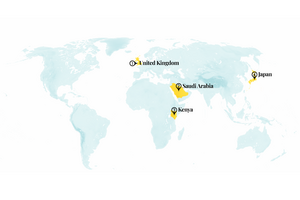Precious water and gold: New extraction methods for arid air and e-waste

The U.K.’s official coin-maker is recovering gold from old electronics
Up to 7% of the world’s gold, a crucial component of circuit boards, is hidden in e-waste. At a new facility in Wales, The Royal Mint is using a process patented by Canadian company Excir to extract that gold and make new products.
To remove the gold, electronic parts are submerged in a chemical bath. The powder that emerges is then melted into gold nuggets. The process works at room temperature, saving energy, and avoids the environmental cost of shipping waste overseas for recycling.
Annually, the plant can recover nearly 1,000 pounds of gold, an amount worth about $34 million as of early August.
Why We Wrote This
In our progress roundup, technologies to recover precious resources range from a low-cost water harvester invented in Saudi Arabia, to the new factory in the United Kingdom that is taking gold from old electronics to make jewelry.
The initiative is part of The Royal Mint’s efforts to expand its business model with the shift away from coins toward digital money. The team is exploring ways to recover other valuable materials such as copper and aluminum from e-waste.
Sources: Fast Company, The Royal Mint, BBC
A new self-sustaining device pulls fresh water from the air using solar power
Usually, solar-powered water extraction systems work only intermittently and require some manual operation. But a new method created by a team at Saudi Arabia’s King Abdullah University of Science and Technology avoids these hang-ups.
An absorbent material first captures moisture from the air. Then, as sunlight heats the device, the water evaporates and is condensed within a sealed chamber. The system automatically cycles between the two stages, allowing it to operate for several weeks without intervention.
The technique produced over half a gallon of water a day in lab testing and successfully irrigated Chinese cabbage and desert trees. The team hopes that a scaled-up version can provide affordable water in low-income arid areas.
Sources: The Independent, Nature
Early warning systems are helping prevent agricultural losses from drought in Kenya
Climate change has worsened droughts in Kenya, threatening food stocks in a region prone to famine. But improvements in data collection, models, and satellite technology are helping farmers better prepare.
A new climate prediction system uses meteorological data to predict droughts as far as eight months in advance, with funding from the government and international agencies. Local officials spread the word using radio, television, and phones, and provide farmers with subsidized seed and fertilizer. The approach gives farmers time to adapt by swapping out crops or agricultural techniques. During droughts in 2016 and 2017, early warnings prevented an estimated 1 million people from going hungry.
One study found that Kenya’s warnings are 92% accurate, although some farmers distrust them due to past failures or spiritual beliefs. The World Bank estimates that spending $1 billion on early warnings can prevent up to $35 billion in losses annually. “We can’t farm like we used to,” says a maize farmer from eastern Kenya. “Now we must rely on climate forecasts.”
Source: Context
Amid declining birth rate, Japanese employers are giving staff with children more flexibility
More municipalities are allowing city employees to bring their children to work if they have no other option. The city of Toyoake implemented the policy after a trial period last year to create a more family-friendly workplace. A survey found that 70% of the city’s employees accept children at work, up from 34% before the trial.
Meanwhile, private companies are building more on-site day care centers with the help of government subsidies. In 2016, the government began covering 75% of an employer’s cost of developing a child care center. At the time, there were fewer than 900 of these centers; by 2022, there were over 4,400. Earlier this year, the government introduced rules requiring companies to provide more support for parents, including shorter days for employees with children not old enough for school and more options for remote work.
Sources: The Japan News, Kyodo News
The number of children not in school fell by 144 million between 2000 and 2023, a drop of almost 40%
The population of children has grown worldwide during that time, making the gains in schooling even more significant.
While overall progress has slowed in recent years, girls have continued to make strides in closing the gender gap in school enrollment. At the turn of the century, 31 million more girls were out of school than boys. By 2019, that gap had narrowed to 1.6 million.
Sources: Our World in Data, United Nations


